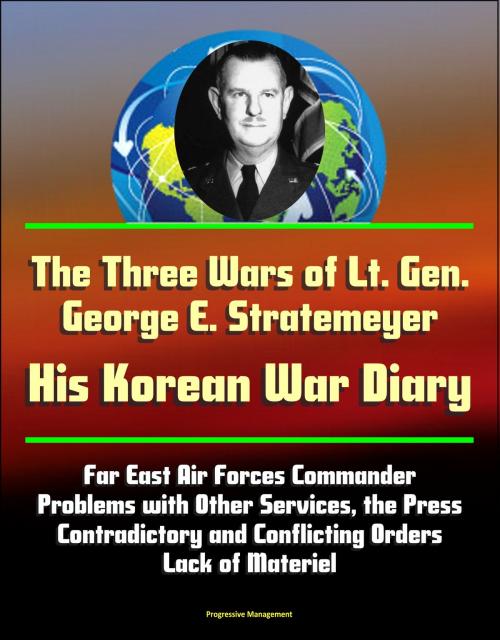The Three Wars of Lt. Gen. George E. Stratemeyer: His Korean War Diary - Far East Air Forces Commander, Problems with Other Services, the Press, Contradictory and Conflicting Orders, Lack of Materiel
Nonfiction, History, Asian, Korean War, Military, Aviation| Author: | Progressive Management | ISBN: | 9781310960703 |
| Publisher: | Progressive Management | Publication: | September 7, 2015 |
| Imprint: | Smashwords Edition | Language: | English |
| Author: | Progressive Management |
| ISBN: | 9781310960703 |
| Publisher: | Progressive Management |
| Publication: | September 7, 2015 |
| Imprint: | Smashwords Edition |
| Language: | English |
This print replica reproduction of an official Air Force book publishes the unique diary of the Korean War written by Lt. Gen. George E. Stratemeyer.
Although some people see the Korean War as just a ground war, it was far more than that. It was the first war the United States Air Force fought as a separate service, and a war in which America's joint service air power team performed sterling work. Without the air dominance gained by Air Force F-86 Sabres against a numerically larger foe, the ground forces would have been left vulnerable to air attack with disastrous consequences. Without the close support and interdiction efforts of the Air Force B-26s, B-29s, F-51s, F-80s and F-84s, and Navy and Marine F9F Panthers, F4U Corsairs, AD Skyraiders and F7F Tigercats, the tasks of the ground forces would have been made immeasurably more difficult. Without the enormous exertions of the C-46s, C-47s, C-54s, and C-119s, supply, sustainment and evacuation of ground forces would have been virtually impossible. Without the men and planes of Lt. Gen. George E. Stratemeyer's Far East Air Forces and their naval and Marine colleagues, the war's denouement may have been entirely different.
This is a unique document. Throughout the years, although often officially frowned upon, officers and men alike have kept diaries. Some of these diaries, primarily from World War Two, have been published. Few, if any, from the Korean War have seen the light of day. Thus General Stratemeyer's diary of the first year of the war provides a unique look at the war from a high level. His diary is rich in the personalities, the operations, the problems and successes, and the behind the scenes maneuverings of the United States' military services in the Far East as they waged the war. Much of what he reveals in his diary is still valid today: proper force size and equipment; accurate and timely intelligence; coordination with the other services; a realization of the impact of media coverage on a war. Despite an organization possessing global capabilities well beyond what Stratemeyer could envision in 1950, these remain the concerns of the United States Air Force today, the centerpiece of America's joint aerospace team. Reading this work confirms one of the great lessons of twentieth century warfare, a lesson applicable to the conflicts of the twenty-first century as well: appropriate and timely use of aerospace power enables both the thwarting of an aggressor's will, and the minimizing of casualties to one's own surface forces.
From June 25, 1950, to May 20, 1951, Lt. Gen. George E. Stratemeyer, the Far East Air Forces commander, kept a diary of his activities during the Korean War. A number of general officers kept such diaries during World War II, although the practice was generally frowned upon by higher headquarters and, in the Navy at least, was against regulations. In the Korean War, the writing of such works became less wide-spread. Surprisingly, however, three diaries written by senior Air Force officers (Stratemeyer, Maj. Gen. Earle E. Partridge, Commander, Fifth Air Force, and Maj. Gen. Edward J. Timberlake, Vice Commander, Fifth Air Force) exist from the Korean War. These three diaries view the war from different perspectives: Stratemeyer's from a high-level planning, strategy, and political viewpoint; Partridge's from a mid-level planning and operational plane; Timberlake's from a slightly lower operational level. This book, however, deals only with General Stratemeyer's diary. It is a valuable document because his position as Far East Air Forces commander allowed him to observe the war and its personalities from a unique perspective.
This print replica reproduction of an official Air Force book publishes the unique diary of the Korean War written by Lt. Gen. George E. Stratemeyer.
Although some people see the Korean War as just a ground war, it was far more than that. It was the first war the United States Air Force fought as a separate service, and a war in which America's joint service air power team performed sterling work. Without the air dominance gained by Air Force F-86 Sabres against a numerically larger foe, the ground forces would have been left vulnerable to air attack with disastrous consequences. Without the close support and interdiction efforts of the Air Force B-26s, B-29s, F-51s, F-80s and F-84s, and Navy and Marine F9F Panthers, F4U Corsairs, AD Skyraiders and F7F Tigercats, the tasks of the ground forces would have been made immeasurably more difficult. Without the enormous exertions of the C-46s, C-47s, C-54s, and C-119s, supply, sustainment and evacuation of ground forces would have been virtually impossible. Without the men and planes of Lt. Gen. George E. Stratemeyer's Far East Air Forces and their naval and Marine colleagues, the war's denouement may have been entirely different.
This is a unique document. Throughout the years, although often officially frowned upon, officers and men alike have kept diaries. Some of these diaries, primarily from World War Two, have been published. Few, if any, from the Korean War have seen the light of day. Thus General Stratemeyer's diary of the first year of the war provides a unique look at the war from a high level. His diary is rich in the personalities, the operations, the problems and successes, and the behind the scenes maneuverings of the United States' military services in the Far East as they waged the war. Much of what he reveals in his diary is still valid today: proper force size and equipment; accurate and timely intelligence; coordination with the other services; a realization of the impact of media coverage on a war. Despite an organization possessing global capabilities well beyond what Stratemeyer could envision in 1950, these remain the concerns of the United States Air Force today, the centerpiece of America's joint aerospace team. Reading this work confirms one of the great lessons of twentieth century warfare, a lesson applicable to the conflicts of the twenty-first century as well: appropriate and timely use of aerospace power enables both the thwarting of an aggressor's will, and the minimizing of casualties to one's own surface forces.
From June 25, 1950, to May 20, 1951, Lt. Gen. George E. Stratemeyer, the Far East Air Forces commander, kept a diary of his activities during the Korean War. A number of general officers kept such diaries during World War II, although the practice was generally frowned upon by higher headquarters and, in the Navy at least, was against regulations. In the Korean War, the writing of such works became less wide-spread. Surprisingly, however, three diaries written by senior Air Force officers (Stratemeyer, Maj. Gen. Earle E. Partridge, Commander, Fifth Air Force, and Maj. Gen. Edward J. Timberlake, Vice Commander, Fifth Air Force) exist from the Korean War. These three diaries view the war from different perspectives: Stratemeyer's from a high-level planning, strategy, and political viewpoint; Partridge's from a mid-level planning and operational plane; Timberlake's from a slightly lower operational level. This book, however, deals only with General Stratemeyer's diary. It is a valuable document because his position as Far East Air Forces commander allowed him to observe the war and its personalities from a unique perspective.















